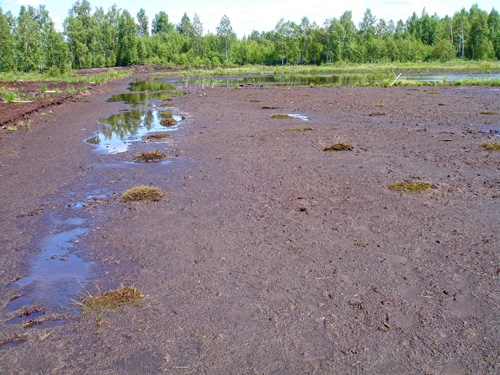
The EU aims to reduce greenhouse gas emissions by 40 percent until 2030 compared to 1990. Therefore conservation of peatlands must be integrated in the climate and energy policy. Especially the Baltic States as well as Poland and Germany have huge areas of peatlands, which are partly heavily degraded and which need conservation and restoration. The project area is one of the global emission Hot Spots, where the potential to save greenhouse gas emissions is exceptionally high.
Effects of drained peatlands on climate
The drainage of peatlands for agricultural use or peat mining contributes severely to the global carbon emissions. During the drainage, oxygen gets into the peat, which leads to aeration and decomposition of organic matter into smallest parts.
In this aerobic zone microorganisms are extremely active, so the rate of decomposition is especially high. As a result the greenhouse gases carbon dioxide (CO2) and nitrous oxide (N2O) are emitted into the atmosphere, what reverses the function of peatlands as a store into a source of greenhouse gases.
From Ice Age to Peatlands
The project area was formed by the ice age with its valleys and depressions. After the latest ice age, the rise in temperatures caused the deglaciation of ice crusts which released huge amounts of water into the landscape. Together with high penetration the water table rose and large areas got flooded. With the time, vegetation adapted to this high water level and complex peatland ecosystems developed.
Project countries
Drained Peatlands: Global Emission Hot Spots
The northern and north-eastern European countries as Latvia and Lithuania have huge peatland areas, which partly reach a few meters in depth. Due to peat mining and the intensification of agriculture and forestry, peatlands were increasingly drained. In these areas peatlands are currently emitting great amounts of greenhouse gases. In the global context Poland and the Baltic States are the Hot Spots of emissions, coming from drained peatlands after Indonesia, Russia and China (Joosten 2010). But also Germany ranks ninth on the global list of emissions of degraded peatlands.
Facts on Climate
Project Aims
References
- Barthelmes, A., Couwenberg, J., Risager, M. Tegetmeyer, C. & Joosten, H. (2015): Peatlands and Climate in a Ramsar context. A Nordic-Baltic Perspective. Copenhagen.
- Cris, R. Buckmaster, S. Bain, C. Reed, M. (Eds) (2014): Global Peatland Restoration demonstrating SUCCESS. IUCN UK National Committee Peatland Programme, Edinburgh. [Status: 17/01/2017]
- FCCC – Framework Convention on Climate Change (2015): National greenhouse gas inventory data for the period 1990-2013, Paris. [Status: 19/01/2017]
- Fourth National Communication under the UN FCCC: in Worldbank (o. J.): Polands Greenhouse gas emissions. [Status: 19/01/2017].
- Joosten, H. (2010): The Global Peatland CO2 Picture. Peatland status and drainage related emissions in all countries of the world. Wetlands International, Greifswald.
- NIR – Nationaler Emissionsbericht (2010): Berechnung der Emissionen aus der deutschen Landwirtschaft – (NIR) 2010 für 2008. [Status: 22/01/2017].
- Sachverständigenrat für Umweltfragen – SRU (2012): Umweltgutachten 2012. Verantwortung in einer begrenzten Welt. Erich Schmidt Verlag. [Status: 13/02/2017]
- Succow, M. (2012): Bedeutung, Funktion und Zustand der Moore in Niedersachsen. Podiumsdiskussion Moorschutz in Niedersachsen. [Status: 13/02/2017]










